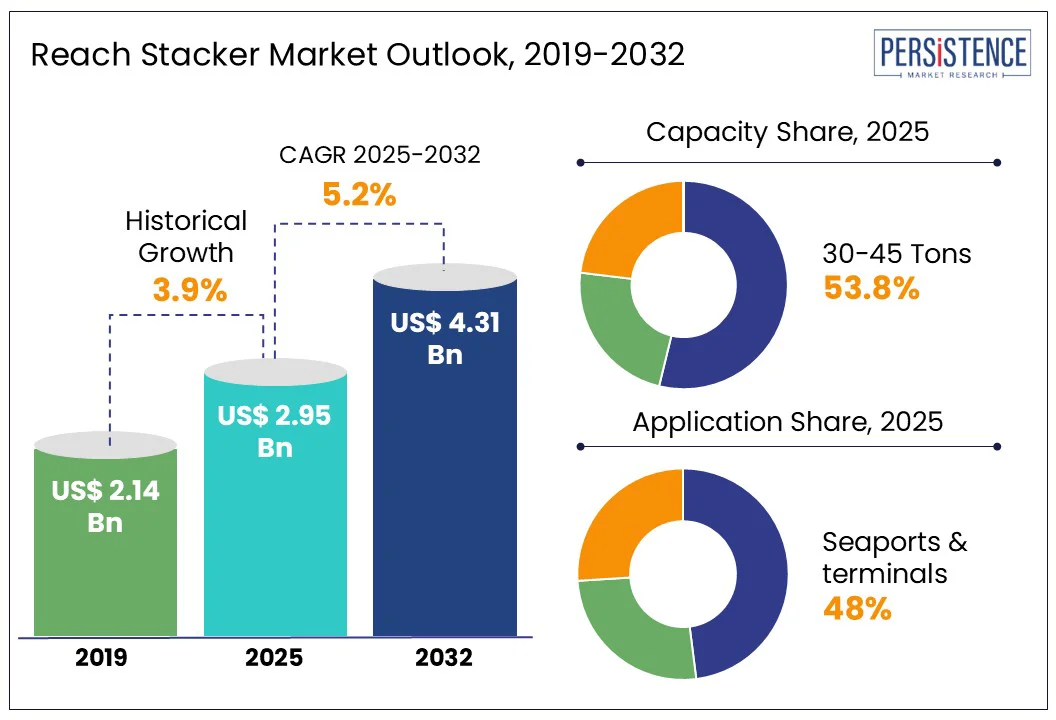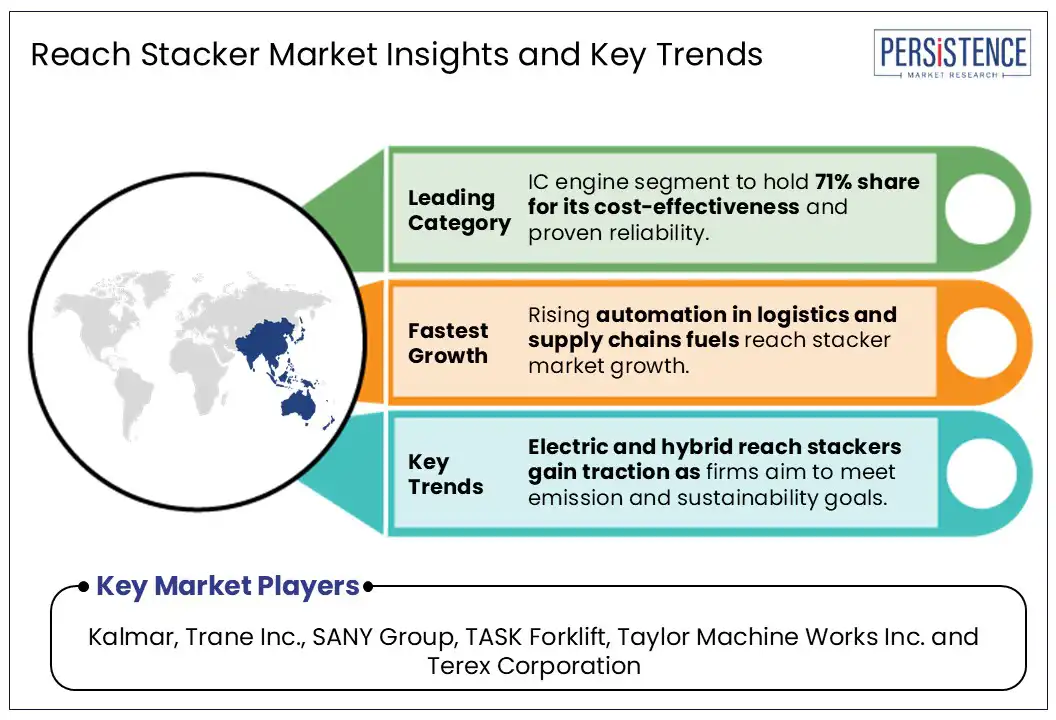ID: PMRREP34869| 189 Pages | 13 Jun 2025 | Format: PDF, Excel, PPT* | Automotive & Transportation

The global reach stacker market size is anticipated to rise from US$2.8 Bn in 2025 to US$ 4.2 Bn by 2032. It is projected to witness a CAGR of 4.5% from 2025 to 2032.
Reach stacker industry growth is largely driven by the expansion of international trade, globalization and flexibility in ease of business . Reach stackers play a vital role in intermodal logistics, facilitating seamless container transfers across rail, road, and sea. The widespread use of standardized 20-foot and 40-foot containers simplifies stacking and handling, making reach stackers indispensable in ports and terminals.
The reach stacker's ability to swiftly move containers to storage areas or vehicles enhances operational efficiency and reduces ship turnaround times. As containerization accelerates port operations, reach stackers remain crucial for supporting the growing need for fast, flexible, and integrated cargo handling across global logistics networks.

Key Industry Highlights:
|
Global Market Attribute |
Key Insights |
|
Reach Stacker Market Size (2025E) |
US$ 2.8 Bn |
|
Market Value Forecast (2032F) |
US$ 4.2 Bn |
|
Projected Growth (CAGR 2025 to 2032) |
5.2% |
|
Historical Market Growth (CAGR 2019 to 2024) |
3.9% |
The global maritime trade has witnessed a significant surge in container traffic at seaports, underscoring the critical need for efficient and high-capacity handling equipment. Reach stackers, renowned for their versatility and capability to manage heavy containers, have emerged as indispensable assets in modern port operations. Their proficiency in stacking containers in multiple rows and heights optimizes space utilization, a crucial factor given the spatial constraints of many ports.
Furthermore, the increase in size of container ships amplifies turnaround times, further enlarging the demand for efficient container handling solutions. As ports continue to modernize and accommodate trade volumes, the reliance on advanced reach stackers is poised to grow correspondingly.
In 2024, DP World achieved a record-breaking milestone by handling 88.3 million twenty-foot equivalent units (TEUs) across its global portfolio of ports and terminals, marking an 8.3% year-on-year growth despite macroeconomic headwinds and global trade uncertainties. Similarly, the Port of Rotterdam, Europe's largest seaport, reported a 2.8% increase in container throughput, reaching 13.8 million TEUs in 2024. This growth is driven by increasing consumer spending and underscores the port's resilience amid global economic challenges.
Reach stackers, though versatile and efficient for container handling in small to mid-sized terminals, face significant limitations in integrating with fully automated port systems, which are increasingly adopted in high-throughput, digitized environments. Unlike automated stacking cranes (ASCs) or rail-mounted gantry (RMG) cranes, reach stackers are not inherently designed for full automation, limiting their compatibility with advanced terminal operating systems (TOS) and vehicle tracking software.
Modern automated terminals rely heavily on precise, real-time data exchange, positioning, and autonomous coordination among various machines. Reach stackers, which depend on human operation, lack the embedded sensors and onboard systems for seamless digital synchronization and autonomous maneuvering. Furthermore, integrating reach stackers into automated workflows can lead to operational inconsistencies and safety risks due to their manual control nature.
Globally, an increase in carbon emissions and climate change have cropped us as a potential challenge for governing bodies of major developed and developing countries. The transportation sector accounts for a major contribution to the greenhouse effect accounting fta he or around 24% of global Co2 emissions. To minimize, the carbon emission from the transportation sector, technologies of low-carbon emission or zero-carbon emission are to be deployed at a vast scale.
In context of zero-carbon emission technologies, alternative fuel vehicles (AFV) offer significant energy sustainable transportation and came up as a potential innovation to address the issue. In the logistics and goods services sector, which even holds a large share in the GDP, zero-emission vehicles are quickly seeking opportunities to electrify the complete ecosystem.
For instance, in July 2022, the Port of Helsingborg of Sweden ordered all-electric Kalmar reach stacker. The electric reach stacker has a wheelbase of 6.5 meters and carries 587 KWh battery pack to deliver power. In addition, the equipment comes with a lifting capacity of 45, 32, and 16 ton variants.
The 31-45 ton lifting capacity segment is estimated to dominate the reach stacker market with 53.8% market share in 2025, owing to its flexibility in handling a wide range of container loads. Reach stackers in this segment can efficiently handle loads from 30-45 tons, allowing port and terminal operators to use a single machine across different jobs. Lighter loads below 30 tons can be handled, but with less productivity compared to specialized smaller capacity machines. Loads above 45 tons require heavier, less maneuverable models. For instance, Terex Corporation, a U.S.-based company and worldwide manufacturer of lifting and material handling equipment, offers up to 45-ton capacity reach stackers that can fulfill the requirements of even the most difficult handling tasks.
The seaports & terminals segment is poised to dominate 48% share of the reach stacker market in 2025. E-commerce and the manufacturing exports have led to a drastic increase in global trade, causing the need for better cargo handling at terminals and seaports. Reach stackers are ideal for such conditions as they can quickly stack containers and gain access to multiple rows in narrow spaces enabling higher throughput and lower turnaround times. The government with private port operators are investing in improving the infrastructure to accommodate larger ships and more containers. For example, a lot of ports are building out their yard storage and container handling capabilities, creating high demand for advanced reach stackers equipped with modern technology such as telematics and automation.

Asia Pacific is expected to dominate the global reach stacker market with a major share of over 40% in 2025. Countries such as India and the ASEAN nations are increasingly industrializing and expanding trade. This growth has caused substantial investments in port infrastructure and logistics networks, which in turn increased the demand for reach stackers to facilitate the smoother movement of goods across borders.
Moreover, China is the leading exporter in the world and a major manufacturing country, retains huge volumes of containerized cargo. To support this, the nation’s efficient logistics, sophisticated material-handling equipment, including reach stackers are extensively used in Chinese ports to maximize port productivity and minimize waiting time. China’s position as a global logistics powerhouse is paralleled by their growing use of reach stacker.
The rise in government initiatives are significantly fostering demand in the North American reach stacker market. Governments in the U.S. and Canada are investing heavily in port infrastructure expansions, upgrades, and new logistics facilities to support increasing international trade volumes and economic growth. These initiatives enhance the efficiency and capacity of container ports, which handle large volumes of cargo that require advanced material handling equipment such as reach stackers.
The growing e-commerce sector in North America further drives demand, as warehouses and distribution centers require efficient container handling solutions to manage rising shipment volumes. In response, manufacturers are innovating to produce more advanced, eco-friendly reach stackers that comply with stringent emission regulations, supported by government policies promoting cleaner technologies.
European reach stacker manufacturers and suppliers focus on advanced technology, safety, and sustainability. Leading companies operating in Europe include Kalmar, Konecranes, Liebherr, SANY, and others, many of which integrate cutting-edge features such as electric powertrains, automation, and telematics to enhance efficiency and reduce emissions. For example, Kalmar offers a broad portfolio of reach stackers designed for high productivity, user-friendly operation, and compliance with updated safety standards such as EN 1175:2020.
SANY, a prominent manufacturer with a strong presence in Europe, builds reach stackers using robust steel components and key parts sourced from reputable European suppliers like Volvo engines, Dana transmissions, Kessler axles, and Parker hydraulics, ensuring high reliability and easy spare parts availability. Their reach stackers are designed for long operational life with minimal downtime, offering over 50,000 hours of productivity across 10 years under real operating conditions. They also emphasize operator comfort and safety with features such as large cabs with excellent visibility and ergonomic multifunction joysticks for precise control.
The global reach stacker market players are enhancing their technological capabilities by integrating advanced telematics, GPS-based fleet tracking, load-sensing hydraulics, and real-time diagnostics. Some manufacturers are exploring semi-autonomous reach stackers to align with evolving smart port ecosystems. Innovations such as low-emission engines, hybrid-electric drives, and energy recovery systems are gaining traction to meet stringent environmental regulations and improve fuel efficiency.
Leading companies are adopting renewable and alternative energy solutions to reduce emissions and operating costs. Manufacturers like Kalmar and Hyster-Yale are investing in electric reach stackers powered by lithium-ion batteries or hydrogen fuel cells, supporting global carbon neutrality goals and green port initiatives.
Major players are expanding through strategic partnerships, local dealer networks, and joint ventures to strengthen presence in Asia-Pacific, Africa, and Latin America. Efficient logistics and parts availability significantly influence buying decisions, particularly in remote and emerging regions.
The market is set to reach US$ 2.8 Bn in 2025.
Growth in Global Container Traffic and Expansion of Inland and Dry Ports are the major growth drivers.
The industry is estimated to rise at a CAGR of 4.5% through 2032.
Expansion of Inland Container Depots (ICDs) and Dry Ports, and Electrification and Green Technology Adoption are the key market opportunities.
Kalmar, Trane Inc., SANY Group, TASK Forklift, Taylor Machine Works Inc., and Terex Corporation are a few leading players.
|
Report Attribute |
Details |
|
Historical Data/Actuals |
2019 - 2024 |
|
Forecast Period |
2025 - 2032 |
|
Market Analysis |
US$ Billion for Value |
|
Geographical Coverage |
|
|
Segmental Coverage |
|
|
Competitive Analysis |
|
|
Report Highlights |
|
|
Customization and Pricing |
Available upon request |
By Propulsion Type
By Capacity
By Application
By Region
Delivery Timelines
For more information on this report and its delivery timelines please get in touch with our sales team.
About Author